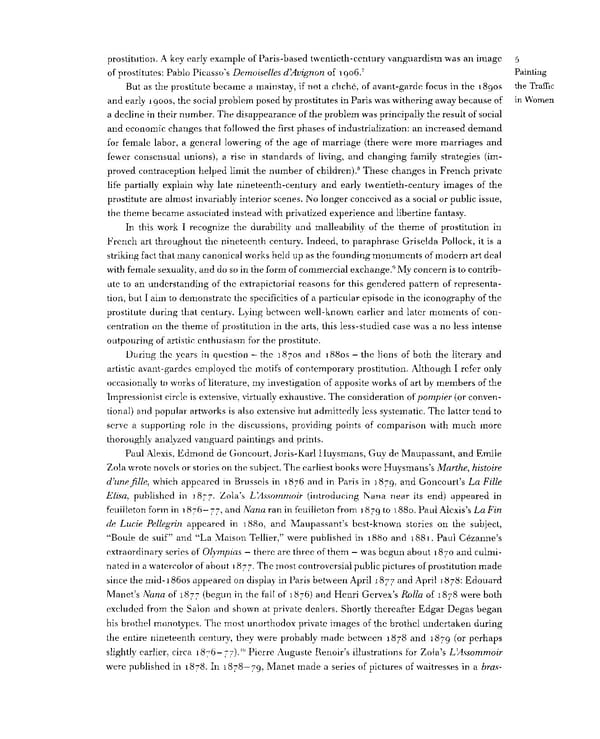prostitution. A key early example of Paris-based twentieth-century vanguardism was an image 5 7 Painting of prostitutes: Pablo Picasso's Demoiselles d'Avignon of igo6. But as the prostitute became a mainstay, if not a cliche, of avant-garde focus in the 18905 the Traffic and early igoos, the social problem posed by prostitutes in Paris was withering away because of in Women a decline in their number. The disappearance of the problem was principally the result of social and economic changes that followed the first phases of industrialization: an increased demand for female labor, a general lowering of the age of marriage (there were more marriages and fewer consensual unions), a rise in standards of living, and changing family strategies (im- 8 proved contraception helped limit the number of children). These changes in French private life partially explain why late nineteenth-century and early twentieth-century images of the prostitute are almost invariably interior scenes. No longer conceived as a social or public issue, the theme became associated instead with privatized experience and libertine fantasy. In this work I recognize the durability and malleability of the theme of prostitution in French art throughout the nineteenth century. Indeed, to paraphrase Griselda Pollock, it is a striking fact that many canonical works held up as the founding monuments of modern art deal 9 with female sexuality, and do so in the form of commercial exchange. My concern is to contrib- ute to an understanding of the extrapictorial reasons for this gendered pattern of representa- tion, but I aim to demonstrate the specificities of a particular episode in the iconography of the prostitute during that century. Lying between well-known earlier and later moments of con- centration on the theme of prostitution in the arts, this less-studied case was a no less intense outpouring of artistic enthusiasm for the prostitute. During the years in question - the 18708 and i88os - the lions of both the literary and artistic avant-gardes employed the motifs of contemporary prostitution. Although I refer only occasionally to works of literature, my investigation of apposite works of art by members of the Impressionist circle is extensive, virtually exhaustive. The consideration of pompier (or conven- tional) and popular artworks is also extensive but admittedly less systematic. The latter tend to serve a supporting role in the discussions, providing points of comparison with much more thoroughly analyzed vanguard paintings and prints. Paul Alexis, Edmond de Goncourt, Joris-Karl Huysmans, Guy de Maupassant, and Emile Zola wrote novels or stories on the subject. The earliest books were Huysmans's Marthe, histoire d'une fille, which appeared in Brussels in 1876 and in Paris in 1879, and Goncourt's La Fille Elisa, published in 1877. Zola's L'Assommoir (introducing Nana near its end) appeared in feuilleton form in 1876 — 77, and Nana ran in feuilleton from 1879 to 1880. Paul Alexis's La Fin de Lucie Pellegrin appeared in 1880, and Maupassant's best-known stories on the subject, "Boule de suif" and "La Maison Tellier," were published in 1880 and 1881. Paul Cezanne's extraordinary series of Olympian — there are three of them — was begun about 1870 and culmi- nated in a watercolor of about 1877. The most controversial public pictures of prostitution made since the mid-i86os appeared on display in Paris between April 1877 and April 1878: Edouard Manet's Nana of 1877 (begun in the fall of 1876) and Henri Gervex's Rolla of 1878 were both excluded from the Salon and shown at private dealers. Shortly thereafter Edgar Degas began his brothel monotypes. The most unorthodox private images of the brothel undertaken during the entire nineteenth century, they were probably made between 1878 and 1879 (or perhaps 10 slightly earlier, circa 1876—77). Pierre Auguste Renoir's illustrations for Zola's UAssommoir were published in 1878. In 1878—79, Manet made a series of pictures of waitresses in a bras-
 Prostitution & Impressionists Page 25 Page 27
Prostitution & Impressionists Page 25 Page 27